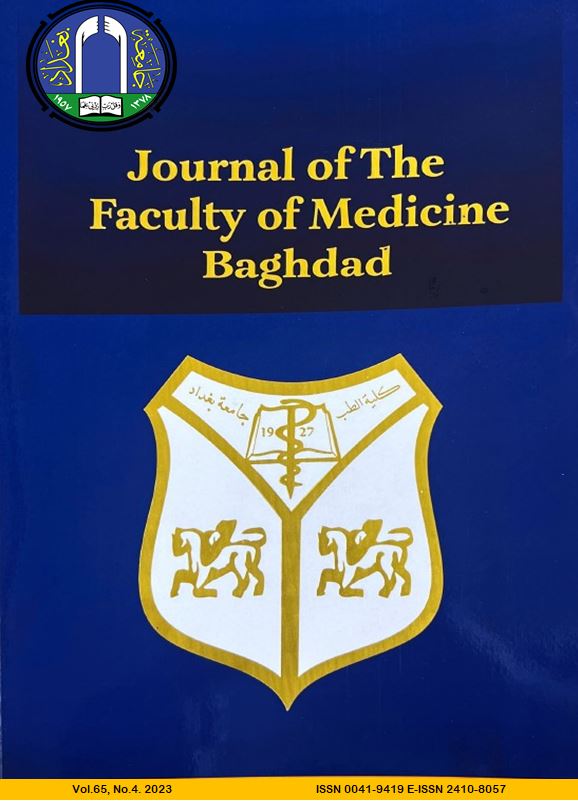Evaluation of Brain Stem Function in Diabetics with and without Distal Symmetrical Polyneuropathy Using the Blink Reflex
DOI:
https://doi.org/10.32007/jfacmedbagdad.1987Keywords:
Blink reflex, Diabetic, Distal Symmetrical PolyneuropathyAbstract
Background: Diabetic peripheral neuropathy (DPN) is the most common complication of T2DM. Neuropathy is a descriptor for a spectrum of clinical and subclinical symptoms with varying anatomical distributions, clinical histories, and perhaps underlying pathogenetic mechanisms. The distal Symmetrical sensory polyneuropathy is chronic, symmetrical, length-dependent sensorimotor. Studies of the blink reflex have shown potential as a method of assessing brainstem activity.
Objective: The primary purpose of this research was to assess the function of the blink reflex in the early detection of cranial nerves and brain stem dysfunction in diabetes patients with and without polyneuropathy. We also aimed to see whether there were differences in blink reflex abnormalities between individuals with and without polyneuropathy.
Methods: The study included a group of sixty diabetic patients. Clinician and electrophysiologist evaluations were used to determine the severity of neuropathy. Patients with diabetes were separated into two groups: those with and without neuropathy.
Results: A statistically significant difference between the two groups was found for C.R.2 latency and I.R.2 latency with a P-value <0.001. Except for the blink reflex’s R1 latency, all other blink reflex parameters were statistically different between patients who experienced diabetic neuropathy and those who didn’t. Regarding HbA1c, a significant positive association with IR2 latency and C.R.2 latency was noted, and a statistically significant negative association was found with I.R.2 duration and C.R.2 duration. Amplitudes of sural, tibial, and peroneal nerves were negatively associated with blink reflex latencies and positively associated with blink reflex duration.
Conclusion: Blink-reflex parameters (including ipsilateral R.2 latency and contralateral R.2 latency) are significantly associated with HBA1C level and degree of peripheral diabetic neuropathy.
Received Sept. 2022
Revised: Nov. 2022
Accepted Nov. 2023
Published Jan. 2024
Downloads
References
1. Wang JT, Medress ZA, Barres BA. Axon degeneration: molecular mechanisms of a self-destruction pathway. Journal of Cell Biology. 2012; 196(1):7-18. https://doi.org/10.1083/jcb.201108111.
2. DyabAllawi AA, Nada SZ, Turki KM. Neutrophil gelatinase associated lipocalin (NGAL) in early detection of nephropathy in type 2 diabetic Iraqi patients. JFacMed Baghdad. 2017 Apr 2;59(1):74-8. https://doi.org/10.32007/jfacmedbagdad.591170.
3. Sabre HJ, Daoud AS. Knowledge and practice about the foot care and the prevalence of the neuropathy among a sample of type 2 diabetic patients in Erbil, Iraq. Journal of Family Medicine and Primary Care. 2018 Sep; 7(5): 967.
https://doi.org/10.4103/jfmpc.jfmpc_163_18.
4. Yaqoub ZA, Kaddori HG, Hamdan FB. The Validity of Different F Wave Parameters in the Diagnosis of Diabetic Axonal Polyneuropathy. Iraqi Journal of Medical Sciences. 2020 Jan 1; 18(1). https://doi.org/10.22578/IJMS.18.1.5.
5. Dyck PJ, Albers JW, Andersen H, Arezzo JC, Biessels GJ, Bril V, Feldman EL, Litchy WJ, O'Brien PC, Russell JW, Toronto Expert Panel on Diabetic Neuropathy. Diabetic polyneuropathies: update on research definition, diagnostic criteria and estimation of severity. Diabetes/metabolism research and reviews. 2011; 27(7): 620-8. https://doi.org/10.1002/dmrr.1226.
6. Hussein LM, Ali SH, Mohammed HN. Electrophysiological evaluation of Guillain-Barre syndrome subtypes in childhood. J Fac Med. 2017;59(1):60-4. https://doi.org/10.32007/jfacmedbagdad.591181.
7. Xiao L, Zou K, Zhou D, Ouyang G, Liu S, Luo J. Changes of Blink Reflex in Type 2 Diabetes Mellitus. Journal of Diabetes Research. 2021 Mar 15; 2021. https://doi.org/10.1155/2021/2473193.
8. Guney F, Demir O, Gonen MS. Blink reflex alterations in diabetic patients with or without polyneuropathy. International Journal of Neuroscience. 2008 Jan 1;118(9):1287-98. https://doi.org/10.1080/00207450701870378.
9. Kimura J. Nerve conduction and needle electromyography. In: WB Saunders. Peripheral neuropathy 2005 Jan 1: 899-969.
https://doi.org/10.1016/B978-0-7216-9491-7.50038-7.
10. Tesfaye S, Boulton AJ, Dyck PJ, et al. Diabetic neuropathies: update on definitions, diagnostic criteria, estimation of severity, and treatments. Diabetes Care. 2010; 33(10):2285-2293. https://doi.org/10.2337/dc10-1303.
11. Tan M, Tan U. Early diagnosis of diabetic neuropathy using double-shock stimulation of peripheral nerves. Clinical neurophysiology. 2003 Aug 1;114(8):1419-22. https://doi.org/10.1016/S1388-2457(03)00154-8.
12. Elkholy SH, Hosny HM, Shalaby NM, El-Hadidy RA, Abd El-Rahim NT, Mohamed MM. Blink reflex in type 2 diabetes mellitus Clinical Neurophysiology. 201431(6):552-555. https://doi.org/10.1097/WNP.0000000000000103.
13. Peddireddy A, Wang K, Svensson P, Arendt-Nielsen L. Influence of age and gender on the jaw-stretch and blink reflexes. Experimental brain research. 2006 Jun;171(4):530-40. https://doi.org/10.1007/s00221-005-0300-y.
14. Kazem SS, Behzad D. Role of blink reflex in diagnosis of subclinical cranial neuropathy in diabetic mellitus type II. American Journal of Physical Medicine & Rehabilitation. 2006; 85(5):. 449-452. https://doi.org/10.1097/01.phm.0000197590.10469.4b.
15. Metwally NA, Elkabeer AM. Clinical utility of facial and dorsal sural nerve conduction studies in patients with type II diabetes mellitus. Aamj. 2014 Jan;12(1):244-55.
16. Schicatano EJ. The effects of attention on the trigeminal blink reflex. Perceptual and Motor Skills. 2016 Apr;122(2):444-51. https://doi.org/10.1177/0031512516640673.
Downloads
Published
Issue
Section
License
Copyright (c) 2023 Sulaf E. Izzat & Ghassan Th. Saeed

This work is licensed under a Creative Commons Attribution 4.0 International License.












 Creative Commons Attribution 4.0 International license..
Creative Commons Attribution 4.0 International license..


